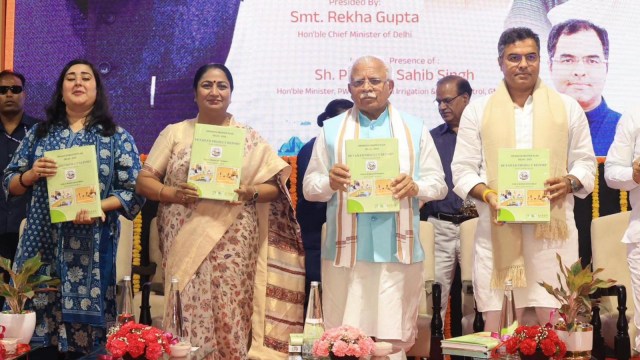Looking at solution for 30 yrs, Govt unveils drainage plan for Delhi
The changes will be implemented with a key focus on critical flood control, expansion and integration across the complete drainage network of 18,958 kilometers, which currently falls under eight different agencies, in the city.
 The plan was unveiled on Friday. Express
The plan was unveiled on Friday. Express Eyeing a 30-year solution for urban flooding in the Capital, Union Minister of Housing and Urban Affairs Manohar Lal on Friday unveiled the BJP government’s ambitious “Delhi Drainage Master Plan 2025” with Chief Minister Rekha Gupta and Public Works Department Minister Parvesh Sahib Singh by his side. Expected to cost around Rs 57,362.85 crore, the plan aims to reduce waterlogging and flood-related incidents in Delhi by 50% in five years by revamping the city’s decades-old drainage network.
It will be implemented in two phases to address present challenges and future demands (see box). “For implementation, the city has been divided into three major basins — Najafgarh, Barapullah, and Trans-Yamuna. Once the detailed project report (DPR) is approved by the government, PWD will invite tenders from private firms to begin on-ground execution and turn this plan into a long-term solution for Delhi’s drainage needs,” said the government in a statement.
The changes will be implemented with a key focus on critical flood control, expansion and integration across the complete drainage network of 18,958 kilometers, which currently falls under eight different agencies, in the city.
According to the master plan, in the first two years, waterlogging hotspots — under different agencies — will be taken care of. From the third year onwards, the work to set up large-scale infrastructure in colonies where there is no drainage network will start. By the completion of five years (2029-2030), final testing and system handover work will be completed.
The plan also suggests improvement in the existing storm water drainage system, and integration of water bodies with the drainage network by directing the excess runoff to lakes, wetlands or other water bodies using nature-based solutions (NBS) such as low impact development (LID) practices as it will reduce the urban flooding while enhancing ecological benefits.
Besides, officials will also focus on the development of green spaces for groundwater recharge and provide a systematic approach to resolving drainage issues, promoting resilience and sustainability in urban storm water management.
For the implementation of the project, Najafgarh Basin, which has a catchment area of 918 square kilometers, will require a cost of around Rs 33,499 crore. The Barapullah Basin, which handles around 80% of the storm water drain, has a catchment area of 376.27 square kilometers. The cost of repair and expansion in this basin is expected to be around Rs 14,547 crore.
Trans-Yamuna covers an area of around 196.93 sqm area and a budget of Rs 9,317 crore is expected to be required for this section under the plan.
Addressing the event, Khattar said that the Centre has always helped Delhi and it will “continue to help the state government with funding to implement the drainage master plan.”
“The new drainage master plan for Delhi is a testament to our commitment to addressing these critical issues. Prepared after years of meticulous consultation, data collection, and study, this comprehensive plan will provide a roadmap for Delhi’s drainage needs, ensuring relief from waterlogging and safeguarding the city from drainage-related challenges,” he said.
He also suggested the government work on a plan to reduce the solid waste in drains like Najafgarh and work on increasing the carrying capacity of the Yamuna river.
Speaking at the event, CM Gupta urged the Centre and Khattar to help the state government in funding this project.
“I urge my brother, Khattar ji present here, to help us in funding the project…he will do it, I know I am his sister,” she said.
The CM also attacked the previous AAP government and challenged AAP chief and former CM Arvind Kejriwal for an open public discussion on Delhi. “He has been a CM for 11 years. I have been a CM for just six months. I am ready to talk and discuss every nook and corner of Delhi,” said Gupta.
She also attacked the AAP government for giving only “Free lollipops” to the public and not doing anything actual work on the ground.
Meanwhile, the PWD minister said, ” “This is not just a drainage master plan, it is a guarantee card of ‘no waterlogging in the city’,” he said.
Parvesh Sahib Singh added, “Since we formed our government we have set an example that we are serious about solving the problems of waterlogging in the city. Minto Bridge underpass is one such example. The previous government could not prevent it from drowning despite being in power for 11 years …we prevented it from drowning in just six months.”
Singh also announced that the government will soon come up with a Sewer Master Plan and Water Master Plan for Delhi to complement this drainage framework and ensure a complete, future-ready water management system for the city.
Further, taking aim at Kejriwal, he said, “If there is a will to do anything, you will do it. Nothing is impossible. But the previous government did not do any study or anything except they were busy building lavish Sheesh Mahal and filling their pockets with public money.”







